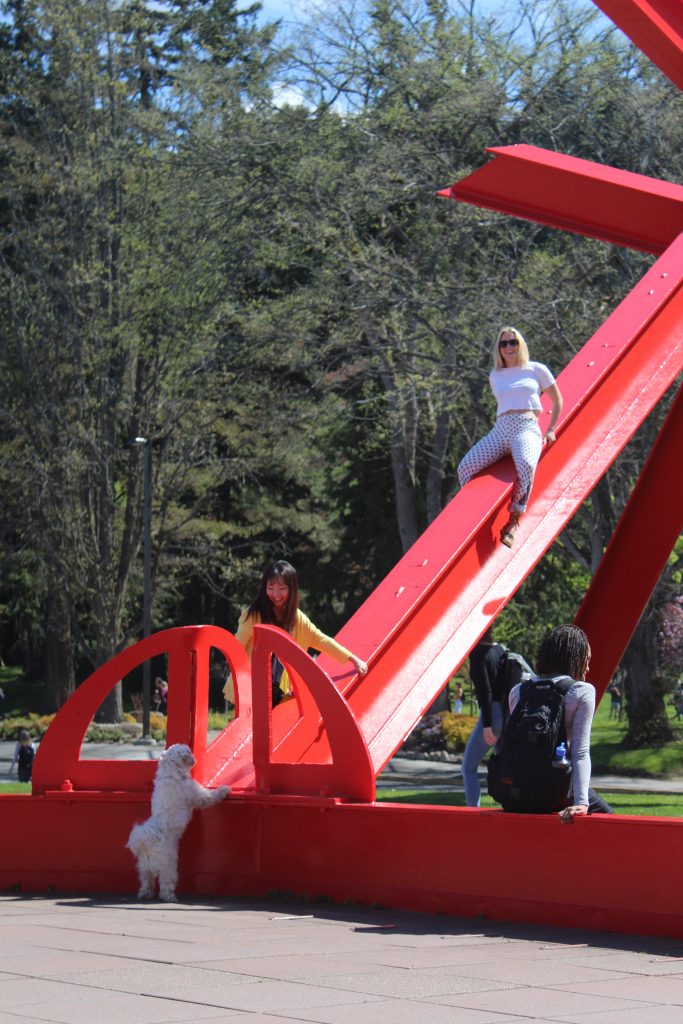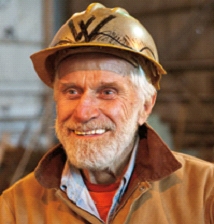The Sculpture
For Handle (1975)
For Handel by Mark di Suervo holds a certain authority over the space it takes up, towering high over students and overlooking the city of Bellingham. This authority, with its strong steely body, is somehow strangely inviting. Its inviting the onlooker to participate in the space it holds together.
In our group’s initial investigation, Ally Parks explained the first time she saw the sculpture: “Some students were climbing up on the structure. I was amazed that students were able to climb up the structure but also worried that they were misusing the sculpture.”

Pictured: Blake Arneson, Photo by: Alise Skiba
But we learned For Handel, and many of Suevro’s other sculptures are meant to be interactive. Swinging elements beg the viewer to play with, on or around his sculpture, tying art and community together. For Handel also originally had a swing, which was taken down as a safety precaution.
What better way to connect students with art than to make them active participants?
Although at first glance For Handle seems like a serious and brooding structure, if you play with/ on it as you wish, you’ll feel like a kid on the playground again.

Pictured: Ally Parks, Alise Skiba, Buddy (the dog). Photo by: Blake Arneson
This sculpture embodies Western Washington University’s spirit: strong, beautiful, and community oriented.
The Artist
Mark di Suervo


Mark di Suervo, or as our group calls him “The Crane Sculptor”, is renowned worldwide for his sculptures which are constructed with large steel beams. These sculptures play with geometry and the precarious nature of balance. In work like For Handle they even represent music. He started toying with the idea of music and metal after hearing the beautiful reverberation metal makes when it is hit.
Suervo’s first shows were in New York, NY in the late 1950’s, as abstract expressionism was booming. The docks in Manhattan influenced his sculpture structure and material. However, the real magic in his work emerged after an accident in the 60s confined him to a wheelchair. Because of this confinement he learned to build with a cherry picker and arc welder. These methods have been pivotal in his work ever since and he sees the crane as “an extension of his arm”. In an interview done in 2003, Mark attributes the beauty of his work not from the materials, but born from the methods those materials were put together.
Suervo is known worldwide for his work with large metal steel beams that mirror geometry and the precarious nature of balance through interaction with the natural and social world around his sculpture.
Works Cited:
Beswetherick, Chris. “Sculpture collection defines Western’s campus.” The AS Review. Ed. /Morgan Annable. The AS Review, 4 Jan. 2017. Web. 26 Apr. 2017. <https://wp.wwu.edu/theasreview/2017/01/04/sculpture-collection-defines-westerns-campus/>.
Castro, Jan Garden. “To Make Meanings Real: A Conversation with Mark di Suvero.” International Sculpture Center. Sculpture Magazine, June 2005. Web. 26 Apr. 2017. <http://www.sculpture.org/documents/scmag05/june_05/disuvero/disuvero.shtml>.
Di Suvero, Mark. Mark di Suvero : retrospective, 1959-1991. Nice : Musee d’Art Moderne et d’Art Contemporain, 1991. Print.
“Mark di Suvero.” Smithsonian American Art Museum and the Renwick Gallery. Smithsonian Institution, n.d. Web. 26 Apr. 2017. <http://americanart.si.edu/collections/search/artist/?id=1279>.
Suvero, Mark Di. “Solo Exhibition at Paula Cooper Gallery .” Mark di Suvero. Mark di Suvero/Spacetime C.C., 2016. Web. 26 Apr. 2017. <http://www.spacetimecc.com/category/news/>.
This post was created by Alise Skiba, Ally Parks and Blake Arneson
Leave a Reply